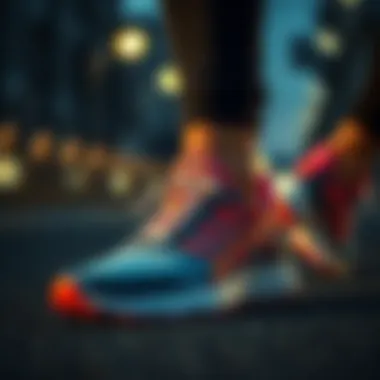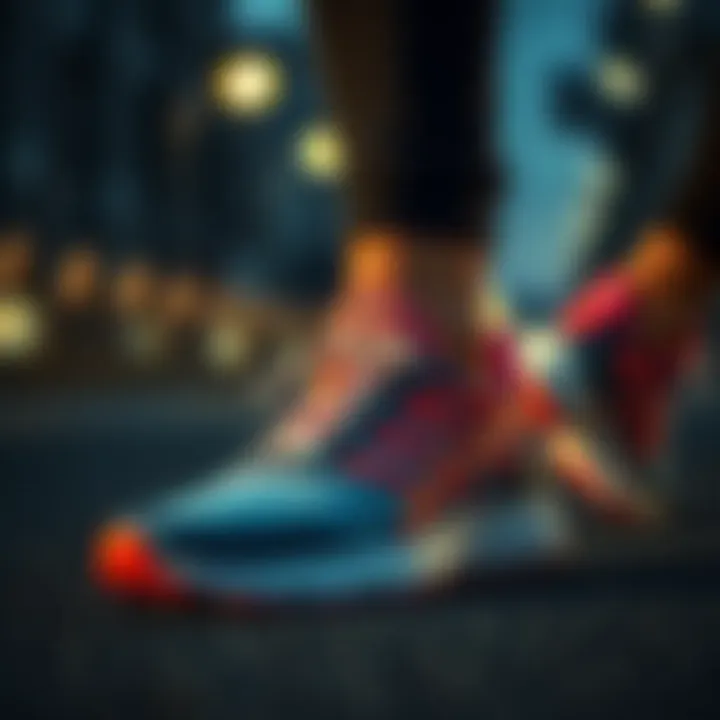Running Active Wear Guide: Choosing the Best Gear


Intro
In the realm of fitness, running retains a special place in the hearts of many enthusiasts, whether you’re a seasoned marathon runner or just someone who enjoys the occasional jog around the block. However, the experience of running can be significantly affected by the gear you choose, particularly your clothing. This guide seeks to explore the world of running active wear and break down the elements that can enhance your performance and comfort.
Active wear designed for running is not just about looking good while you dash; it’s about function and adaptability. The right apparel can make a huge difference in breathability, moisture-wicking capabilities, and overall comfort, which inevitably impacts performance. Whether you're clocking in miles on a hot summer day or braving the chill of winter, the materials, technology, and design considerations become vital.
Moreover, with the growing emphasis on sustainability within the fashion industry, it's essential to know how eco-friendly practices are blending with style and functionality.
As we navigate through this comprehensive guide, we'll delve into the intricacies of fabric knowledge, style tips, and what features to consider when selecting your running gear. This will help equip fitness enthusiasts and style aficionados alike with a deeper understanding of how apparel plays a crucial role in the running experience.
Foreword to Running Active Wear
When it comes to running, just like any other physical endeavor, the right clothing can make a significant impact on performance and comfort. While one might think that any old t-shirt and shorts will do, diving deeper reveals a complex world of specialized fabrics and designs tailored for the needs of runners. The right active wear not only enhances movement but also plays a crucial role in moisture management, body temperature regulation, and injury prevention.
Importance of Choosing the Right Gear
Selecting the appropriate running gear is akin to choosing the right tools for a craftsman. The materials influence both comfort levels and ultimately how well a runner can perform on their track. Here’s a closer look at why this choice is incredibly critical:
- Comfort and Fit: The fit of running wear can significantly affect performance. Tight garments may impede movement, while overly loose clothes can create drag. A snug but flexible fit promotes better aerodynamics and reduces chafing.
- Temperature Control: Running actively raises body temperature. Efficient fabric choices can wick moisture and allow airflow, keeping the athlete comfortable. Fabrics like polyester, for example, dry quickly and help in maintaining optimal body heat.
- Injury Prevention: Certain running wear features include support that can aid in reducing the risk of injury. Compression apparel can enhance blood flow, which might facilitate better muscle recovery during and after runs.
"The right gear is not just fashion; it’s about enhancing your performance and enjoying the run more."
- Confidence Boost: How one feels in their gear often affects performance and mindset. Whether it’s a vibrant color or a sleek design, feeling good can lead to better improvements in every stride.
Fabric Technologies in Active Wear
Understanding fabric technologies is vital when it comes to choosing the best running active wear. The materials used in this clothing serve multiple purposes including performance enhancement, comfort, and protection from the elements. As we delve into the specifics of fabric technologies, it’s important to recognize how they can affect your running experience and help you achieve your fitness goals. With advancements in technology, active wear has evolved, bringing not just style but also functional benefits that cater to avid runners and casual joggers alike.
Moisture-Wicking Properties
One of the standout features of high-quality active wear is its moisture-wicking capabilities. This specific property allows sweat to be pulled away from the skin, transferring it to the outer surface of the fabric where it can evaporate more easily. It’s about keeping you dry during those intense runs when you're sure to break a sweat.
- Why It Matters: The primary benefit here is comfort. Fabrics that wick away moisture can significantly reduce chafing, which occurs when wet material rubs against the skin. This is especially important for long-distance runners who may spend hours in their gear.
- Materials to Look For: Polyester and nylon are common materials utilized for their moisture-wicking properties. Some brands combine these with special coatings or treatments to enhance their effectiveness and longevity.
- Real-World Example: Consider the difference between running in a cotton T-shirt and a moisture-wicking top. Cotton absorbs sweat but holds onto it, creating a heavy, damp fabric against your skin. In contrast, a polyester blend shirt is light and quick-drying, letting you focus on your pace rather than discomfort.
Breathability and Ventilation
If you're serious about running, breathability in your active wear can’t be overlooked. This refers to how well the fabric can allow air to flow through, which helps regulate your body temperature. Whether you're in a packed urban environment or on a scenic trail, breathability can enhance your overall performance.
- Key Aspects: Fabrics with breathable properties allow moisture not only to escape but also ensure that fresh air can enter. This is crucial on warm days when overheating can lead to fatigue or diminished performance.
- Tech Innovations: Advanced fabric technologies, such as mesh panels and laser-cut ventilation zones, have become popular for providing airflow while maintaining support and coverage. Some brands utilize specific weaves that create tiny channels within the fabric to facilitate air movement.
- User Experience: Think about a summer morning run. Wearing a non-breathable top can quickly turn into an uncomfortable situation with heat build-up. A well-ventilated running shirt will feel cool against the skin and can make a world of difference in performance.
Durability and Resistance
Durability is another cornerstone of effective running active wear. When investing in gear, you want to ensure it can withstand the rigors of running. This includes exposure to elements such as rain, wind, and UV rays, as well as the wear and tear from regular use.
- What to Consider: Durability not only impacts how long the garment lasts but also its ability to maintain performance features over time. Fabrics should be resistant to stretching, fading, and losing their shape.
- Common Materials: Look for blended fabrics that incorporate elastane or spandex for stretchability alongside synthetic fibers like nylon for durability. These fabrics offer a robust solution, able to resist snagging and tearing.
- Real-Life Impact: Imagine training for a marathon; you're going to clock in countless miles during training. A durable pair of running shorts will maintain their structure and functionality long after repeated washes, unlike cheaper alternatives that may fray and lose their elasticity, leaving you feeling less than secure mid-stride.
It's clear that understanding the nuances of fabric technology can profoundly impact your running experience. Making informed choices based on these features will help you find the gear that not only looks great but enhances your performance accordingly.
Key Features of Running Active Wear
When it comes to running, the right gear can make or break the experience. Among the many aspects to consider, the key features of running active wear play a pivotal role in enhancing both performance and comfort. This section explores these essential elements—fit, reflective elements for safety, and pockets and storage solutions—providing valuable insights for those who take their running seriously.
Fit and Comfort
Perhaps the most significant aspect when selecting running active wear is the fit and comfort of each piece. Garments that are too tight can restrict movement, while those that are too loose may not offer the support needed during intense activities. Quality running apparel typically employs ergonomic design principles, ensuring that it moves with the body rather than against it.
A snug yet flexible fit helps in reducing chafing and irritation, allowing the runner to focus on their stride rather than their apparel. Look for options with flat seams or seamless designs as they drastically reduce friction. Additionally, many brands now offer garments in various lengths and cuts, catering to different body types and preferences.
"The right fit not only supports performance but can also boost confidence during a run."


Comfort is equally essential. Fabrics that are soft against the skin, coupled with good moisture management, make an invaluable difference. No one enjoys a sticky, damp shirt clinging to their body halfway through a jog. Therefore, pay attention to the fabric composition and look for blends that enhance flexibility and breathability.
Reflective Elements for Safety
For many, running extends to the early hours of the morning or after dusk, making visibility a crucial element. Reflective details woven into running active wear keep runners safe in lower light conditions. These reflective elements are often enhanced by contemporary design, seamlessly integrating into the aesthetics of the apparel.
Whether it’s strips along the sides of a running jacket or spots on the back of a pair of tights, these reflective features maximize visibility to drivers and pedestrians alike. Moreover, certain brands offer integrated LED sensors for an even higher safety level, making you look both stylish and safe on your nightly runs.
In essence, these elements should not merely be an afterthought; they are a vital consideration for anyone aiming to run in varied light conditions without compromising safety.
Pockets and Storage Solutions
In building the ideal running ensemble, storage solutions are often overlooked. However, having pockets in the right places can be a game-changer. Imagine heading out for a run with a place to securely stow your essentials—keys, phone, or energy gels.
Many brands have shifted their focus to include thoughtfully designed pockets that maintain the garment's sleek silhouette while offering ample space. Depending on your preference, you might find:
- Zippered pockets on jackets for securely storing valuables.
- Built-in compartments in tights to hold phones or cards during longer runs without bouncing around.
- Compression pockets that hug close to the body, reducing bulkiness.
Ultimately, pockets serve practical functions while adhering to the athletic aesthetic that runners appreciate. Prioritizing designs with smart storage options can significantly elevate your running experience.
Types of Running Active Wear
When it comes to running, the kind of gear you don can make a world of difference. The right active wear not only influences performance but also affects comfort and overall enjoyment during your runs. Let’s first break down the major types of running active wear, discussing their unique features and benefits.
Tops and Tees
Choosing the right top is more than just a style statement; it impacts your body temperature and comfort level. There’s a lot of choices, from tank tops to long sleeves, and each has its own purpose. Light, breathable materials like polyester or blends can keep sweating at bay and help wick moisture away from your skin. Running tops should also have some stretch to allow for a full range of motion.
- Fit Matters: A snug fit ensures the fabric works with you, while a looser design offers more airflow. Find what feels right!
- Seamless Options: Many tops today come with seamless designs that reduce chafing – a common issue runners face.
- Designs and Colors: Bright colors might be more visible to cars and cyclists, making safety a key consideration.
Shorts and Tights
Just like tops, the right shorts or tights can make all the difference in your run. Each option has its own fit and fabric considerations.
- Shorts: Typically made from lightweight materials, running shorts may include built-in liners for extra support. They should have enough give to ensure they won't restrict your movements.
- Tights: On the other hand, running tights are perfect for cooler weather. Look for compression options, as they provide muscle support, improving blood circulation.
Notably, brands like Nike and Under Armour design varied styles tailored for different body types, ensuring everyone finds something that fits like a glove.
Outerwear and Cold Weather Gear
Running in the chill can be a challenge. That's where outerwear comes into play, shielding you from wind, wet, and colder temperatures. Here are some options:
- Windbreakers: These are typically lightweight, yet effective at blocking wind and keeping warmth in. Look for versions with ventilation to avoid overheating during your run.
- Insulated Jackets: A heavier jacket is suitable for particularly frigid temperatures. Brands like Columbia often use unique insulation technology, which traps heat without bulk.
- Accessories: Don't overlook hats, gloves, and thermal socks as critical components of your ensemble when temperatures dip. They can dramatically enhance your comfort levels.
A well-selected piece of outerwear can transform an arctic run into a pleasant adventure, allowing you to maintain motivation even in the frostiest months.
In summary, understanding the various types of running active wear allows you to tailor your purchases to fit your specific needs. Remember, the key is to remain comfortable and prepared, allowing you to focus on the stride ahead. For those interested in more resources on running gear, check out Active.com for expert advice.
Gender-Specific Considerations
When it comes to running active wear, recognizing gender-specific considerations is paramount. Not only do men and women have unique body shapes and sizes, but their needs during a run can differ significantly due to anatomical differences and comfort preferences. This section is vital as it provides tailored insights, helping both casual runners and seasoned athletes make informed choices about the gear they don.
Women’s Running Wear
Women’s running clothing has evolved dramatically over the years, catering to the diverse needs of female athletes. One of the key aspects is the fit. Women tend to have a higher waist and curvier hips, necessitating designs that offer adequate room in these areas without compromising functionality. For instance, sports bras tailored for women vary greatly in support levels, providing options for everything from low-impact yoga runs to high-intensity marathons. Brands like Lululemon and Nike have honed in on this, creating styles that not only provide support but also feature moisture-wicking materials to keep sweat at bay.
Moreover, many women prefer pockets in their running attire for convenience. Women’s shorts often feature hidden pockets for carrying essentials like keys or energy gels, allowing for a more seamless running experience.
Color and design also play a significant role in women’s active wear. Light colors are commonly favored, especially in warmer months, not only for style but also for temperature regulation. Unique patterns and colors can help women express their personality while running, making the experience more enjoyable.
In summary, when selecting women’s running wear, it’s essential to consider fit, comfort, design, and practicality. Gear that complements their physique while addressing their specific needs can enhance their running experience significantly.


Men’s Running Wear
On the flip side, men’s running wear tends to focus less on form-fitting designs and more on functionality. Men generally have broader shoulders and a straighter body type, which influences how garments are tailored. A prime example is the cut of tank tops and shorts. These are designed to allow for greater range of motion and ventilation, crucial for performing at peak levels during a run. Brands such as Adidas and Under Armour focus significantly on these aspects, utilizing heats and moisture management technologies.
Another important consideration for men is the type of waistband in shorts. Many men prefer either elastic or drawstring waists, as this provides an additional level of adjustability and comfort during running. Also, lightweight materials are key for men’s shorts, as they often deal with more friction and chafing during longer runs. Incorporating mesh panels is common for enhanced breathability.
Men also tend to favor understated colors but are increasingly exploring bolder options. This shift signals a growing acceptance and desire for personal expression through running gear.
Sporting socks specifically designed for men can also not be overlooked.
"Choosing the can significantly impact performance and comfort, making it an investment worth the thoughtful consideration."
For further insights into running apparel, you can check resources such as Wikipedia, Academy of Nutrition and Dietetics, and Runner’s World.
Sizing and Fit: Finding the Right Size
Choosing the right size in running active wear can feel like a task in itself, yet it is paramount for optimal performance. The wrong fit can not only result in discomfort but can also affect your overall running experience. Often, runners may underestimate how fit influences movement. When gear is snug in the right places, it reduces drag, helping you glide through your runs effortlessly. Conversely, baggy fit can create excess fabric that flaps around—hardly ideal when trying to maintain focus and pace.
Understanding Measurements
Getting measurements right can sometimes seem like splitting hairs, yet every small detail counts when you are selecting active wear. To find your ideal fit, it’s best to start with understanding your body measurements. Here are some fundamental areas to consider:
- Chest: Measure around the fullest part of the chest while keeping the tape level. This ensures tops sit well and don’t chafe.
- Waist: A simple measurement around the narrowest part of your waist is key. If you choose bottoms that don’t hug your waist properly, you might find them slipping or causing discomfort.
- Hips: This measurement is crucial for tights and shorts. Measure at the widest part of your hips to ensure they fit without being restrictive.
- Inseam: For pants or tights, the inseam (the length from the crotch to the ankle) can make or break comfort levels.
Achieving the correct size often means mixing and matching between different brands due to variances in sizing scales. Many brands provide sizing charts, so don’t shy away from using them before making a purchase. Here’s a brief overview of why this step is essential:
- Comfort: Gear that fits well allows for unrestricted movement, which is critical for any running session.
- Support: Properly fitting gear provides necessary support to muscles, allowing them to perform at their best.
- Performance: Gear that fits just right delivers less friction, letting you concentrate on your pace rather than constantly adjusting your apparel.
"When you feel good in your gear, you run better."
The reality is that measures like the above can help you find not only the right size but also the right brand that caters to your unique fit. Always remember that trying items on, if possible, is wise. If you can't, be sure to check the return policy of the retailer you are buying from. Get those measurements nailed down, and you're halfway to finding active wear that works with you, not against you.
Sustainability in Running Active Wear
In recent years, the conversation around sustainability has gained remarkable momentum, hitting home across industries—even footwear and clothing. Running active wear is no exception. With fitness enthusiasts increasingly seeking gear that aligns with their values, understanding sustainability in this niche is vital for both consumers and retailers. Not only does sustainable active wear reduce environmental impact, but it also fosters a deeper connection between wearers and the planet.
Issues such as pollution and resource depletion loom large over the fashion industry, so choosing eco-friendly options can make a significant difference in mitigating these concerns. Moreover, as athletes are always on the lookout for high-quality performance gear, sustainable options often do not skimp on technology or durability.
Eco-friendly Materials
The backbone of sustainable running gear lies in the materials used. When we talk about eco-friendly materials, we're diving into a category that boasts both innovation and responsibility. Common choices include recycled polyester, organic cotton, and even natural fibers like bamboo.
- Recycled Polyester: This material is made from post-consumer plastic bottles, turning waste into valuable running gear. This process reduces dependency on virgin petroleum sources and significantly cuts down on energy and water use.
- Organic Cotton: Grown without harmful pesticides or synthetic fertilizers, organic cotton offers a kinder alternative to conventional cotton, promoting better soil health while providing a soft, breathable fabric for runners.
- Bamboo Fabric: Gaining traction for its sustainability, bamboo grows quickly with little water and no pesticides. Fabrics made from bamboo are not only biodegradable, but they also possess natural moisture-wicking properties, making them ideal for running gear.
By opting for these materials, consumers can support companies that prioritize terrestrial well-being and contribute to a circular economy. It's a win-win: better running experience for you and a healthier planet.
Ethical Production Practices
Ethical production practices are another pillar of sustainability in running active wear. It's one thing to use eco-friendly materials, but if workers are poorly treated or safety practices are ignored, then the production is not genuinely sustainable.
- Fair Trade Certification: Look for brands that emphasize fair trade. This certification ensures that workers are paid fairly for their labor, work under safe conditions, and are not subject to exploitative practices.
- Transparent Supply Chains: Brands that are open about their manufacturing processes and supply chains show greater accountability. This transparency allows consumers to understand where and how their active wear is being made.
- Support for Local Communities: Some brands actively engage with their local environments by sourcing materials and labor from nearby areas. This minimizes transportation emissions and promotes community development.
Ultimately, incorporating ethical practices into production enhances both the social and environmental responsibility of the active wear industry. It builds trust and loyalty among consumers, who are more aware than ever of the impacts of their purchasing decisions.
"The relationship between performance gear and sustainability is not just an afterthought. It's a necessity for modern athletes who value both efficiency and ethical considerations on their journey to personal excellence."
The Impact of Technology on Performance
In recent years, technology has made a monumental stamp on the world of performance apparel. For runners, this means the difference between merely putting one foot in front of the other and truly maximizing each session. The incorporation of innovative technologies not only enhances comfort and performance but also ensures that runners are better equipped to meet their goals.
Smart Fabrics and Wearables


Smart fabrics and wearable technology are the new superheroes in the realm of running gear. These garments can adapt to environmental conditions and body movements, providing benefits that traditional fabrics simply can’t offer. Think of smart fabrics that convert your body heat into energy, powering small devices you might want to take on a run.
Also, wearables like heart rate monitors and GPS watches have transformed how we train. These devices link to various apps, tracking metrics such as pace, distance, and even recovery time. They help runners understand their physical states better, allowing for data-driven training adjustments, which is a game changer for performance optimization.
"In a world driven by data, having accurate feedback can turn a runner into an athlete."
App Integration for Tracking Metrics
App integration has become an integral part of the running experience. While runners used to rely on basic watches and anecdotal performance records, today’s technology offers a dynamic solution. Applications such as Strava, RunKeeper, and Nike Run Club allow for real-time tracking and detailed analysis of your runs.
These apps don’t just monitor distances; they provide insights into altitude gained, calories burned, and even routes run. Many allow users to create challenges or engage with a community for added motivation. The ability to look back on this data provides an element of accountability. It pushes runners to set goals and continuously strive for improvement.
Here are some features found in modern running apps:
- Customizable Training Plans: Tailoring workouts based on individual goals.
- Social Sharing Options: Connecting with friends and other runners.
- Performance Analytics: Reviewing trends over time, analyzing progress.
As such, runners today can train smarter, not just harder. Technology provides a crucial edge that can finesse their performance through precise insights, elevating the running experience from ordinary to extraordinary.
Caring for Your Active Wear
Caring for your running active wear might seem like an afterthought amidst the thrill of running. However, how you handle your gear can significantly affect its lifespan, functionality, and overall performance. Just as you take the time to choose the right gear for your running style, ensuring the longevity and efficiency of that gear warrants equal attention. The right kind of care can enhance breathability, maintain moisture-wicking properties, and prevent wear and tear, ultimately making your running experience more enjoyable.
Investing time into proper maintenance isn't merely about keeping your clothes fresh; it's also a way to respect the innovation and technology woven into these fabrics. Many running enthusiasts understand that active wear is often designed with intricate fabric technologies that require specific care methods to function correctly. Let’s delve into some effective tips to care for your active wear and keep it in top shape for those countless miles ahead.
Washing and Maintenance Tips
When it comes to washing and maintaining your running gear, the rules often differ from your everyday laundry practices. Here are some actionable tips that might help your gear last longer:
- Read the Labels: Always start by checking the care label. Each piece of clothing has specific washing instructions tailored to the fabric.
- Cold Water is Your Friend: Washing your gear in cold water helps maintain color and elasticity. Hot water can break down the fibers, rendering the fabric less effective at wicking moisture.
- Avoid Fabric Softeners: While it might seem appealing to keep your gear smelling fresh, fabric softeners can coat the fibers. This coating reduces the moisture-wicking capabilities essential for running.
- Skip the Dryer: Air drying is recommended over machine drying. The heat from dryers can shrink, fade, and damage the fabric. Instead, find a good place to hang your clothes and let them air dry naturally.
- Separate Your Gear: Keep your active wear away from rougher fabrics like towels or denim in the wash. This prevents friction that can lead to pilling or tearing.
- Use a Gentle Cycle: If using a washing machine, opt for a gentler cycle to minimize the agitation that could wear out the fabric faster.
Proper care can lengthen the lifespan of your gear and maintain its performance. Even with advanced features, the right washing techniques play a crucial role in keeping everything in working order.
By following these simple maintenance tips, you can ensure that your running gear remains in optimal condition, maintaining the comfort and performance you need. Tending to your gear is as essential as your running routine; it shows that you value the investment you’ve made for your fitness journey. If your running is a passion, then treating your gear with a little tender loving care can go a long way.
Trends in Running Active Wear
When it comes to running active wear, staying up-to-date with the latest trends is crucial. Not only do these trends influence the aesthetics of what you wear, but they also play a significant role in the functionality and effectiveness of your gear. Being aware of what's current in the market allows runners to choose products that not only look good but also enhance performance and comfort.
The trends in running apparel often stem from advancements in technology, shifts in consumer preferences, and evolving fashion sensibilities. Understanding these aspects can greatly benefit fashion enthusiasts, retailers, and stylists alike. In this section, let's dive deeper into some notable color and design trends that are shaping the future of running active wear.
Color and Design Trends
The color and design of running gear are no longer merely afterthoughts. They have become integral parts of the apparel experience, resonating with the user's personal style. Here are a few key points highlighting the significance of color and design in running active wear:
- Psychological Impact: Colors can influence mood and motivation. For example, vibrant colors like electric blue or neon green can energize and inspire runners, while softer tones can present a more calming effect. Choosing the right shade can affect not only motivation but also performance during runs.
- Visibility for Safety: In an age where safety is paramount, reflective elements and bold colors are making headlines. Runners who head out during early morning or late evening hours benefit immensely from gear that stands out, reducing the risk of accidents.
- Personal Style: The trend towards individualized style choices in fitness apparel is gaining momentum. Performance and aesthetics are now intertwined; brands are increasingly offering designs that appeal to specific fashion sensibilities, whether it's minimalist or bold graphics.
- Sustainability in Colors: There’s a growing shift towards eco-friendly dyes and sustainable production methods. Textiles dyed with natural pigments are creating a buzz and appealing to environmentally conscious consumers who want to express their values through their wardrobe.
“The right colors and designs can not only boost your confidence but also contribute to effective performance.”
So, as you scour the latest offerings on the market, keep in mind the importance of finding that sweet spot where style meets functionality. A well-chosen outfit in your favorite hue can invigorate your workouts while ensuring you stay safe and comfortable.
For more insights, check resources like Wikipedia and Britannica to explore further how fashion intersects with sports and active lifestyles.
Concluding Thoughts
The topic of running active wear serves as a vital component in the overall experience of any runner. As we've traversed through the nuanced elements of materials, technologies, and fit, it's clear that the choices consumers make can significantly impact not only their performance but also their enjoyment of the sport.
The Future of Running Active Wear
Looking ahead, several forces are shaping the direction of this industry. Here are some key elements and considerations:
- Innovation in Materials: As research continues, expect materials that are not only lighter and more breathable but also smarter. These fabrics will integrate sensors to monitor health metrics directly.
- Sustainable Practices: Many brands are acknowledging the need to balance performance with environmental responsibility. Eco-friendly materials and ethical manufacturing processes are becoming more mainstream. This shift influences consumer purchasing decisions, especially among the environmentally conscious demographic.
- Customization and Personalization: As technology advances, the ability for consumers to customize their running gear based on personal preferences—such as fit, color, and even performance features—will likely expand.
- Wearable Technology: The integration of wearables into running gear can provide real-time feedback. This could change how runners train, making data-driven decisions more accessible and actionable.
The evolving landscape holds plenty of promise, making it an exciting time for both runners and manufacturers. As you come away from this exploration, consider how these emerging trends might influence your gear selections in the future.
"The right active wear doesn’t just enhance performance; it can redefine your relationship with running."
In summary, the intersection of technology, fashion, and environmental consciousness sets the stage for a new era of running active wear. It's a sphere that's worth watching, as this evolution will not just influence how we perform but shape the very culture around running itself.















